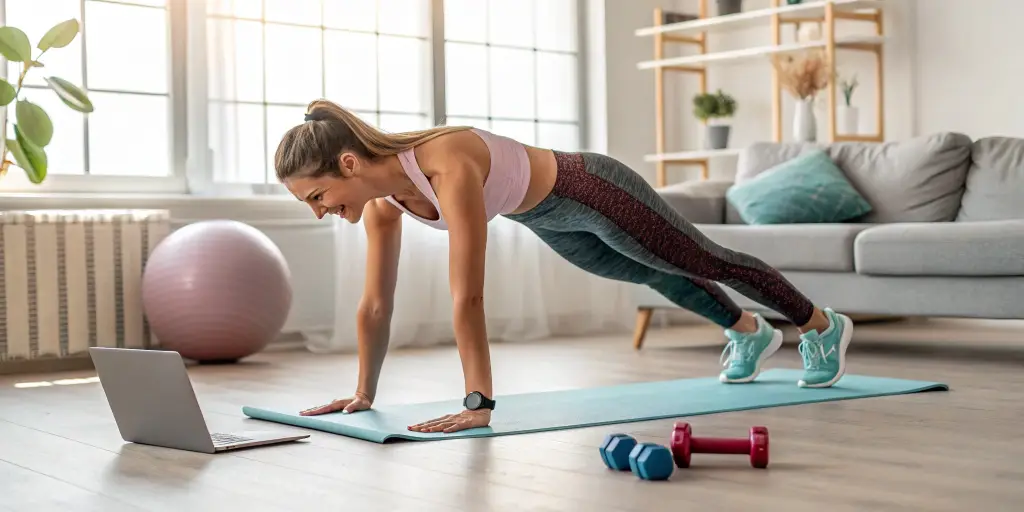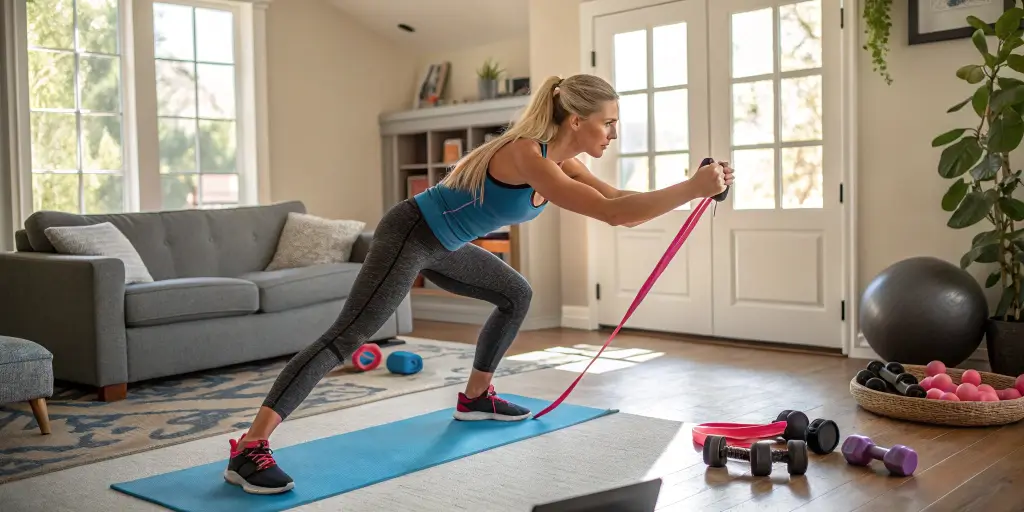I don’t have time” is a common excuse for skipping workouts. But, what if you could turn that excuse into action? Even just five minutes of daily exercise can make a big difference. For example, stretching during a Zoom call or climbing stairs during breaks can lower blood pressure and boost your mood.
The American Heart Association says consistency is key, not how long you exercise. Doing 30 minutes daily, in short sessions like three 10-minute walks, can lead to real results. Whether you’re a busy parent or a professional with unpredictable hours, this guide will help you create a workout routine that fits your lif

Key Takeaways
- Even 5 minutes of daily exercise reduces stress and improves health, per the American Heart Association.
- HIIT workouts under 20 minutes can match longer sessions in results.
- Walking laps during errands or doing calf raises while waiting counts toward your daily activity.
- Setting small goals like 5,000 extra steps a day boosts long-term adherence.
- 80% of people stick to routines when they schedule workouts like meetings.
Understanding the Fitness Challenge for Busy Professionals
Finding time to work out when you’re busy can be tough. Many people find it hard to keep up with a workout routine because of work hours and deadlines. But, not exercising regularly can harm your health. Let’s look at why a custom

The Impact of Inconsistent Exercise on Physical Health
Not exercising regularly can slow down your progress. It can:
- Reduce your heart’s ability to work by 10-15% in just weeks
- Make your muscles shrink, mainly in your core and legs
- Make it harder to keep your weight stable
Experts say you need at least 150 minutes of moderate exercise each week to avoid these issues.
Mental Health Benefits of Regular Physical Activity
Exercise is good for your mind too. Studies show it can:
- Lower cortisol levels by 20-30%, which helps with stress
- Boost serotonin, which helps your mood stay stable
- Improve sleep by 25-40% for those who exercise regularly
Putting fitness first helps you deal with stressful work better.
Why Traditional Workout Advice Often Fails Busy Individuals
| Traditional Advice | Modern Approach |
|---|---|
| “Commit 60 minutes daily at the gym” | 15-minute HIIT sessions 3x/week |
| Requires rigid scheduling | Adapts to a busy schedule |
| Focuses on volume over consistency | Emphasizes small, achievable sessions |
Old advice doesn’t fit real life. New methods focus on quality, not just how much you do. This way, you can prioritize fitness without changing your whole life.
Assessing Your Current Schedule and Fitness Level
Before you create a workout routine, it’s important to know your daily routine and fitness level. Start by tracking your busy schedule for a week. Note when you have more energy and when you’re tired. Look for small gaps in your day, like 10 minutes, for quick workouts.

- Perform a 12-minute Cooper Test run to gauge cardiovascular health.
- Try the Rockport Walk Test for non-runners: walk 1 mile at a steady pace, then measure heart rate recovery.
- Hold a plank for as long as possible to assess core strength.
Then, think about your exercise plan possibilities. Ask yourself if you can commit to 30 minutes, five times a week. Or if 10-minute bursts fit better into your busy schedule? Use apps like Apple Fitness or MyFitnessPal to track your daily activities.
Remember, even short “exercise snacks” count towards your weekly goal of 150 minutes. Be honest about your limits, starting slow is best for beginners. Wearable tech like Fitbit or Garmin helps track your progress and improve your routine.
Small changes can make a big difference. A study in Exercise and Sports Science Reviews showed that short activity bursts can reduce sitting risks. Use this information to create a routine that fits your lifestyle perfectly.
Setting Realistic Fitness Goals When Time Is Limited

Time constraints don’t have to stop you from staying fit. Begin by defining goals that fit into your daily routine. Studies show that short goals like doing three 20-minute workouts a week help you stay on track. Long-term goals, like running a 5K, keep you motivated by showing your progress.
“Accumulating three 10-minute exercise bouts daily matches the benefits of a single 30-minute session,” states the American College of Sports Medicine.
Distinguishing Between Short-Term and Long-Term Objectives
Here’s a table to help you understand different goals:
| Short-Term (1-2 Weeks) | Long-Term (3-6 Months) |
|---|---|
| Walk 10,000 steps daily | Complete a 5K run |
| Do 20 minutes of HIIT 3x weekly | Build strength to lift 50% body weight in pull-ups |
Creating Measurable Milestones
Here’s how to make your goals clear:
- Use a fitness app to track your progress weekly.
- Adjust your workout schedule to include 10-15 minute micro-sessions.
- Make your exercise plan flexible—switch gym days for home workouts when needed.
Adapting Goals to Changing Schedules
Life can change your plans. Here’s how to adapt:
- Replace 30-minute sessions with two 15-minute fitness routine splits.
- Do “minimum viable workouts”—10 minutes of bodyweight exercises when you’re busy.
- Check your goals monthly to make sure they match your schedule.
Small, consistent efforts add up over time. Even 20 minutes of high-intensity intervals 3x weekly can make a difference. Focus on being consistent, not perfect, to build a lasting exercise plan.
How to Create an Easy-to-Follow Workout Routine, Even with a Busy Schedule
Creating a lasting workout routine is all about keeping it simple. Choose exercises that are both efficient and effective. Here’s how to craft workout routine plans that fit your busy life:

- Progressive Overload: Slowly increase the intensity, like adding 30 seconds to your HIIT intervals each week.
- Recovery Time: Take 30 seconds to rest between sets. This helps your muscles recover without losing your pace.
- Exercise Selection: Focus on exercises that work multiple joints at once, like squats or push-ups. They burn calories fast and are quick.
Balancing Exercise Types
It’s important to mix cardio, strength, and flexibility for the best results. Here’s a simple way to do it:
- 20% cardio (e.g., jump rope)
- 60% strength (bodyweight circuits)
- 20% mobility (yoga stretches)
Sample Templates for Any Schedule
Find a routine that fits your time:
- 15-Minute: Start with a 5-min jog, then do a 5-min bodyweight circuit (squats, planks). Finish with 5-min yoga stretches.
- 30-Minute: Begin with 10-min HIIT intervals, followed by 10-min strength training. End with 10-min dynamic stretching.
- 45-Minute: Start with a 15-min brisk walk, then do a 20-min resistance band workout. Finish with 10-min yoga.
“Even 10 minutes of exercise daily improves mood and energy,” says research from the University of British Columbia. Consistency matters more than duration.
Customize these templates to meet your goals. Use a 30-liter backpack with sneakers to turn lunch breaks into walk breaks. Combine these tips with realistic goals to create an easy workout routine that you can stick to.
Time-Efficient Workout Strategies That Deliver Results
You don’t need to spend hours at the gym to get fit. Time-efficient workout methods like HIIT, Tabata, and choosing the right exercises can help you build strength and endurance in just 20 minutes. Here are the top strategies to make fitness fit into your busy schedule.
- HIIT and Tabata: These 20-30 minute sessions of high-intensity intervals (like 20 seconds work/10 seconds rest for Tabata) boost your metabolism and endurance. Studies show they offer the same benefits as longer workouts.
- Circuits and Supersets: Doing exercises together (like squats + push-ups without rest) saves time. Compound movements like deadlifts or lunges work multiple muscles at once, making your workout routine more efficient.
- Smart Volume: Research shows even 1-3 weekly sessions can build strength if you optimize the volume (sets/reps). Beginners see strength gains with single sets, while advanced trainees see 46% higher gains with multiple sets.
Focus on multi-joint exercises like squats or rows—they burn more calories and build functional strength than isolation moves. The American College of Sports Medicine recommends 6-12 RM loads for strength, achievable in quick, focused sets. Add 5-minute dynamic warm-ups and track your progress with fitness apps. Your easy workout routine can fit into lunch breaks or morning routines, making 15-30 minutes count.
Integrating Exercise Into Your Daily Activities
Turning everyday routines into opportunities for movement can change a busy schedule into a hidden fitness routine. Small changes can make exercise a natural part of your day, not an extra task.
Transforming Commute Time Into Active Time
Try walking, biking, or parking farther away instead of driving. Marisa Cummings runs 6.5 miles to her Manhattan office and showers at the gym before work. Garret Woodward keeps a gym bag in his car for quick runs. Even a 20-minute walk to the train station helps meet the CDC’s weekly activity goal.
- Walk or bike to nearby errands
- Take the stairs instead of elevators
- Pair errands with brisk walking sessions
Maximizing Lunch Breaks for Quick Fitness Sessions
Use your lunch break for a structured . Jessica Derschowitz goes to the gym midday, and Jenna Deutsch uses a calendar reminder. A 20-minute HIIT session can burn calories efficiently with exercises like squats, lunges, or jumping jacks. Keep a change of clothes in your desk drawer for freshness.
Creating Movement Opportunities in a Desk-Bound Day
Desk work doesn’t mean sitting all day. Gia Alvarez takes micro-breaks every hour for calf raises or shoulder stretches. Walking during calls, climbing stairs for coffee, or using a standing desk can burn up to 50 calories an hour. Even pacing during phone calls helps!
Small choices add up. Every step, stretch, or active break brings you closer to your fitness goals—no extra time needed.
Technology and Tools to Streamline Your Fitness Routine
Modern technology makes fitness easy to fit into your day. Apps like 8fit and Aaptiv use AI to customize your workout routine. They adjust the intensity and length based on your schedule and progress. These apps offer quick HIIT sessions and meditation breaks, saving time and boosting engagement by up to 50%.
“AI-driven workout schedules can reduce planning time by 15-20% while improving adherence,”
notes a Penn State study on mobile app efficacy.
Apps That Optimize Workout Efficiency
- Apple Fitness+ ($9.99/month) pairs with Apple Watch for real-time feedback during treadmill runs or yoga flows.
- Blogilates ($3.99/month) offers on-demand Pilates routines to fit into tight fitness routine gaps.
- Jefit ($12.99/month) tracks sets/reps across 1,500+ exercises, auto-scheduling rest days to prevent burnout.
Home Equipment Worth the Investment
Maximize space with versatile gear like:
- Adjustable dumbbells (e.g., ProSource Fitness) that eliminate clutter.
- Resistance bands for full-body strength training in under 15 minutes.
- Smart scales (e.g., iHealth Core) linking to fitness apps for holistic tracking.
Digital Accountability Systems
Tools like Strava or MyFitnessPal sync across devices. Virtual training platforms like Centr ($29.99/month) connect you with trainers for live sessions. Wearables like Fitbit or Garmin provide real-time metrics, ensuring your workout schedule stays on track without added stress.
Overcoming Common Barriers to Consistent Exercise
Even with the best intentions, common barriers like time constraints and mental fatigue can disrupt your workout routine. Whether you’re juggling a busy schedule or struggling to stay motivated, these challenges don’t have to end your fitness journey. Here’s how to tackle the obstacles blocking your progress.
Research shows 60% of adults cite lack of time as a major hurdle. Yet small adjustments can make a big difference. Below are strategies to overcome the most frequent barriers:
| Barrier | Strategy | Example |
|---|---|---|
| Lack of Time | Break workouts into 10-minute segments | Three 10-minute walks daily count as a full 30-minute workout |
| Decision Fatigue | Plan workouts in advance to reduce choices | Choose your exercise and time the night before |
| Low Energy | Start with short sessions | A 5-minute stretch or yoga flow before starting your day |
| Social Obligations | Involve family or friends | Take a walk with a coworker during lunch breaks |
Adopting flexible approaches helps. For example, use hotel gyms during travel or turn chores into exercise (e.g., taking stairs instead of elevators. Prioritize fitness by adjusting your approach—small steps keep you moving forward. Even 10-minute sessions count toward your weekly goals.
Research shows that scheduling workouts as appointments increases consistency by 80%, making it a key strategy for those with busy schedules. Remember, progress comes from persistence, not perfection. Every effort to prioritize fitness matters, even when life gets hectic.
Maintaining Motivation When Life Gets Overwhelming
Staying motivated when life gets crazy is key. Focus on making small wins into lasting habits. Even when your workout schedule gets disrupted, keep moving forward by aiming for consistency, not perfection.
Creating Reward Systems That Reinforce Habits
Small rewards can help you stick to your exercise plan. Try these tips:
- Pair post-workout treats (like a podcast or a 10-minute walk) to make exercise fun
- Give yourself mini-rewards for hitting milestones, like completing 10 sessions in a month
Building a Support Network
Share your fitness goals with friends or join groups like ACE Fitness communities. Use apps like Strava to track your progress with others. Letting others know your workout schedule helps you stay accountable.
Adjusting Your Mindset About “Perfect” Workouts
| Mental Toughness C’s | Description |
|---|---|
| Confidence | Believe in small gains |
| Consistency | Focus on daily habits over intensity |
| Commitment | Stick to your exercise plan even on off days |
Remember, a 10-minute workout schedule is better than skipping it. Celebrate your progress, not perfection, to prioritize fitness.
Conclusion: Prioritizing Fitness as a Non-Negotiable Part of Your Busy Life
Creating an easy workout routine isn’t about finding extra hours. It’s about making time-efficient workout choices that fit your life. Studies show even 15–20 minute sessions boost energy by 20% and reduce stress.
The NSCA guidelines confirm short, consistent efforts outperform sporadic longer workouts. To create workout routine success, treat fitness like any critical task. Schedule it, track progress, and adapt as needed.
Start with a time-efficient workout like 15-minute HIIT or a 20-minute walk. Use apps or home gear to simplify your plan. Remember, professionals who prioritize fitness report 25% higher productivity and better mental clarity.
Consistency, not perfection, drives results. 10 minutes of mobility work or a quick run can fit into even the busiest days.
Stick to your plan by focusing on movement over motivation. A 15-minute daily habit builds toward the CDC’s 150-minute weekly goal. Discipline, not willpower, ensures long-term success.
Begin now—block time in your calendar, set small milestones, and let fitness fuel your work and well-being. Your health isn’t a luxury; it’s the foundation of a productive, resilient life.


